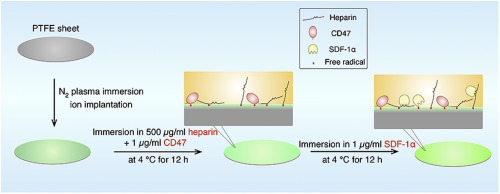当前位置:
X-MOL 学术
›
Biomaterials
›
论文详情
Our official English website, www.x-mol.net, welcomes your
feedback! (Note: you will need to create a separate account there.)
Linker-free covalent immobilization of heparin, SDF-1α, and CD47 on PTFE surface for antithrombogenicity, endothelialization and anti-inflammation
Biomaterials ( IF 12.8 ) Pub Date : 2017-06-20 00:00:00 , DOI: 10.1016/j.biomaterials.2017.06.023
Ang Gao , Ruiqiang Hang , Wan Li , Wei Zhang , Penghui Li , Guomin Wang , Long Bai , Xue-Feng Yu , Huaiyu Wang , Liping Tong , Paul K. Chu
Biomaterials ( IF 12.8 ) Pub Date : 2017-06-20 00:00:00 , DOI: 10.1016/j.biomaterials.2017.06.023
Ang Gao , Ruiqiang Hang , Wan Li , Wei Zhang , Penghui Li , Guomin Wang , Long Bai , Xue-Feng Yu , Huaiyu Wang , Liping Tong , Paul K. Chu

|
Small-diameter vascular grafts made of biomedical polytetrafluoroethylene (PTFE) suffer from the poor long-term patency rate originating from thrombosis and intimal hyperplasia, which can be ascribed to the insufficient endothelialization and chronic inflammation of the materials. Hence, bio-functionalization of PTFE grafts is highly desirable to circumvent these disadvantages. In this study, a versatile “implantation-incubation” approach in which the biomedical PTFE is initially modified by plasma immersion ion implantation (PIII) is described. After the N2 PIII treatment, the surface of biomedical PTFE is roughened with nanostructures and more importantly, the abundant free radicals generated underneath the surface continuously migrate to the surface and react with environmental molecules. Taking advantage of this mechanism, various biomolecules with different functions can be steadily immobilized on the surface of PTFE by simple solution immersion. As examples, three typical biomolecules, heparin, SDF-1α, and CD47, are covalently grafted onto the PTFE. In addition to retaining the bioactivity, the surface-functionalized PTFE exhibits reduced thrombogenicity, facilitates the recruitment of endothelial progenitor cells, and even alleviates the inflammatory immune responses of monocytes-macrophages and is thus promising to the development of small-diameter prosthetic vascular grafts with good long-term patency.
中文翻译:

肝素,SDF-1α和CD47的无接头共价固定在PTFE表面上以抗血栓形成,内皮化和消炎
由生物医学聚四氟乙烯(PTFE)制成的小直径血管移植物因血栓形成和内膜增生而长期通畅率低,这可归因于材料的内皮化不足和慢性炎症。因此,非常需要PTFE接枝的生物功能化来克服这些缺点。在这项研究中,描述了一种通用的“植入-孵育”方法,其中首先通过等离子浸入离子植入(PIII)对生物医学PTFE进行改性。N 2之后PIII处理后,生物医学PTFE的表面被纳米结构粗糙化,更重要的是,在表面之下产生的大量自由基不断迁移到表面并与环境分子发生反应。利用这种机制,可以通过简单的溶液浸渍将具有不同功能的各种生物分子稳定地固定在PTFE的表面上。例如,将三种典型的生物分子肝素,SDF-1α和CD47共价接枝到PTFE上。除了保留生物活性外,表面功能化的PTFE还显示出降低的血栓形成性,促进了内皮祖细胞的募集,
更新日期:2017-06-26
中文翻译:

肝素,SDF-1α和CD47的无接头共价固定在PTFE表面上以抗血栓形成,内皮化和消炎
由生物医学聚四氟乙烯(PTFE)制成的小直径血管移植物因血栓形成和内膜增生而长期通畅率低,这可归因于材料的内皮化不足和慢性炎症。因此,非常需要PTFE接枝的生物功能化来克服这些缺点。在这项研究中,描述了一种通用的“植入-孵育”方法,其中首先通过等离子浸入离子植入(PIII)对生物医学PTFE进行改性。N 2之后PIII处理后,生物医学PTFE的表面被纳米结构粗糙化,更重要的是,在表面之下产生的大量自由基不断迁移到表面并与环境分子发生反应。利用这种机制,可以通过简单的溶液浸渍将具有不同功能的各种生物分子稳定地固定在PTFE的表面上。例如,将三种典型的生物分子肝素,SDF-1α和CD47共价接枝到PTFE上。除了保留生物活性外,表面功能化的PTFE还显示出降低的血栓形成性,促进了内皮祖细胞的募集,































 京公网安备 11010802027423号
京公网安备 11010802027423号